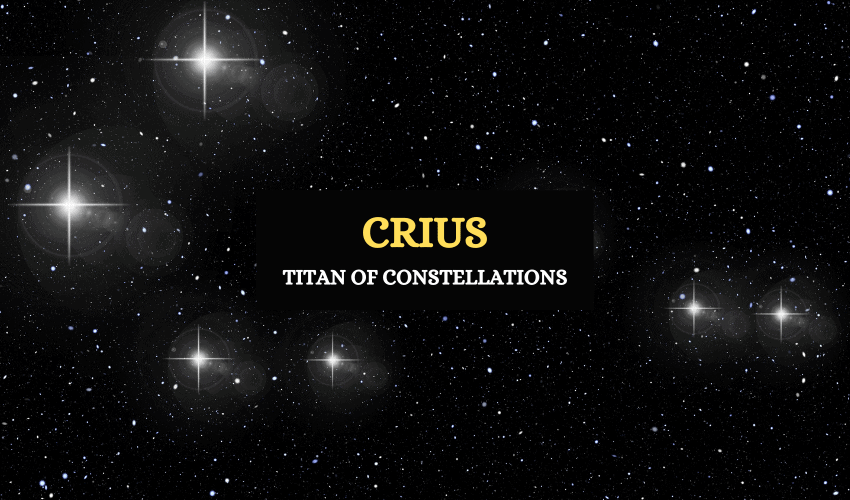
Table of Contents
In Greek mythology, Crius was a first generation Titan and the god of constellations. Although he’s not one of the most famous deities among the Titans and is mentioned in very few sources, he did play an important role in mythology.
The Origins of Crius
Crius was one of twelve highly powerful offspring born to the primordial beings Gaia (the Earth) and Uranus (the god of the sky). He had five brothers: Cronus, Iapetus, Coeus, Hyperion and Oceanus, and six sisters: Rhea, Theia, Tethys, Mnemosyne, Phoebe and Themis. Crius also had two more sets of siblings by the same parents, known as the Cyclopes and the Hecatonchires.
Crius was born in a time before gods existed, when the cosmos was ruled by the primordial deities who personified cosmic and natural forces.
His father Uranus, the supreme deity of the cosmos, believed that his own children were a threat to him so he locked up the Hecatonchires and the Cyclopes in the belly of the earth. However, he underestimated his Titan children and let them roam free because he never imagined that they would be a threat to him.
Crius and his five Titan brothers conspired against Uranus with their mother Gaia and when he descended from the heavens to be with her, they held him down and Cronus castrated him. According to the myth, the four brothers who held Uranus down symbolize the four cosmic pillars that separated the Earth and heavens. Since Crius held his father down at the southern corner of the world, he was closely associated with the southern pillar.
Crius The God of Constellations
Although Crius was the Greek god of constellations, his brother Oceanus also had a certain amount of power over celestial bodies. It was believed that Crius was responsible for measuring the duration of the entire year, while another of his brothers, Hyperion measured the days and months.
The connection Crius had with the south was found both in his family connections and in his name (which means ‘ram’ in Greek). He was the ram, the Ares constellation that rose in the south each spring, marking the start of the Greek year. It’s the first visible constellation at the spring season.
Crius was typically depicted as a young man with the head and horns of a ram similar to the Libyan god Ammon but sometimes, he’s portrayed as a ram-shaped goat.
The Offspring of Crius
The Titans normally partnered with one another but this was different in Crius’ case for he found himself a beautiful wife, Eurybia, the daughter of Gaia and Pontus (the ancient, primordial god of the sea). Eurybia and Crius had three sons: Perses, Pallas and Astraeus.
- Astraeus, Crius’ eldest son, was the god of the planets and stars. He had several children including the Astra Planet, the five wandering stars, and the Anemoi, the four wind gods.
- Perses was the god of destruction and through him, Crius became grandfather to Hecate, the goddess of witchcraft.
- Pallas, Crius’ third son, was the god of battle craft, who was defeated by the goddess Athena during the Titanomachy.
According to the Greek traveler Pausanias, Crius had another son called Python who was a violent bandit. However, in most myths, Python was a monstrous snake-like beast that was sent by Zeus’ wife Hera to chase Leto around the country. Leto, the mother of the twins Apollo and Artemis, continued to be chased by Python until Apollo finally killed him.
Crius in the Titanomachy
Crius and the other Titans were eventually defeated by Zeus and the Olympian gods which ended the ten-year war known as the Titanomachy. He was said to have fought alongside many other male Titans against the Olympians and their allies.
Once the war ended, Zeus punished all those who had opposed him by imprisoning them in Tartarus, a dungeon of suffering and torment in the Underworld. Crius, too, was imprisoned with the rest of the Titans in Tartarus for eternity.
However, according to Aeschylus, Zeus granted the Titans clemency once he’d secured his position as the supreme deity of the cosmos and they were all released from Tartarus.
In Brief
Hardly any sources mention the Greek god of constellations and he never appears in any myths of his own. However, he may have featured in the myths of other deities and Greek heroes. Although he didn’t have a specific role in the Titanomachy, he was doomed to suffer eternal punishment in the deep abyss that is Tartarus, with the rest of the Titans.








